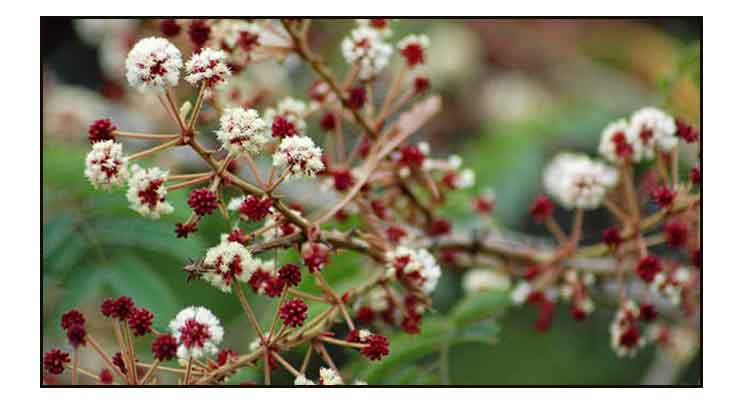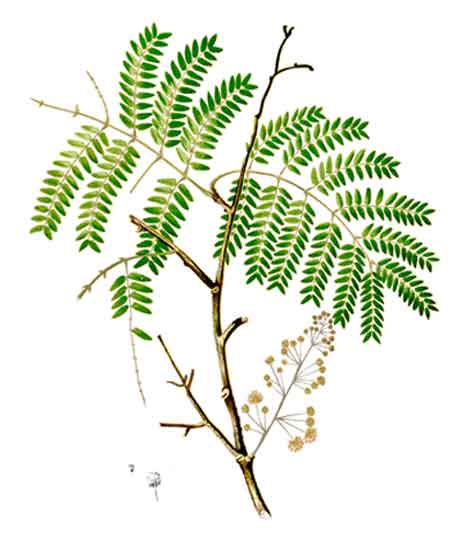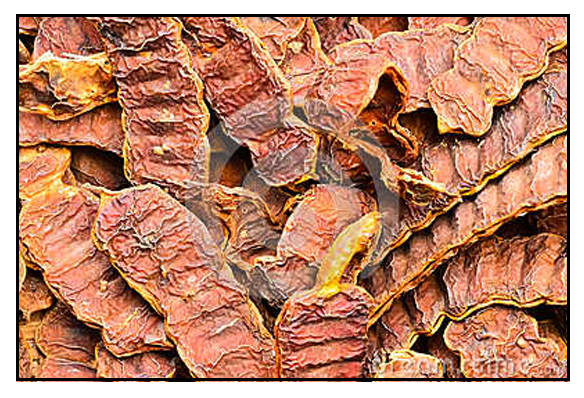 Botany Botany
Acacia concinna is a scandent, prickly shrub or climber reaching a height of 4 to 5 meters. Branches are gray and armed with short, sharp prickles. Leaves are pinnately compound, 15 to 25 centimeters long, and with 8 to 10 pairs of pinnae. Rachis has one gland near the base, and one of two near the apex. Leaflets number 20 to 32 pairs on each pinnae, are linear-oblong, 8 to 10 millimeters in length, with a pointed tip and subtruncate base. Midrib is oblique. Panicles are terminal, in the upper axils, and ample. Heads are yellow, about 1 centimeter in diameter. Pods are straight, somewhat fleshy, flat, 7 to 10 centimeters long, and about 2 centimeters wide.
Distribution
- In Benguet, La Union, and Ilocos Sur Provinces in Luzon, in thickets at low and medium altitudes.
- Also occurs in India to southern China and Malaya.
 Constituents Constituents
- Soft parts of the dried berries contain 5% saponin.
- Pods have yielded several saponins including kinmoonosides A-C, triterpenoidal prosapogenols names concinnosides A, B, C, D and E with four glycosides, acaciaside, julibroside A1, albiziasaponin C and their aglycone, acacic acid lactone.
- Phytochemical screening of the plant yielded flavanoids, saponins, terpenoids and tannins.
- Phytochemical screening of pods yielded alkaloids, flavonoids, phytosterols, saponin, tannins, phenolic compounds, gums and mucilage. (see study below) (6)
- The pods contain
several saponins, highly polar compounds, such as prosapogenol, and monoterpene glycoside in in various plant parts. The bark yields high levels of saponins, which are forming agents and natural surfactants.
Properties
- Pod is acid, bitter, and singularly pungent; considered deobstruent, astringent and detergent.
- Studies have suggested antibacterial, antioxidant, antiviral, antifungal, antithrombotic, antioxidant, antidermatophytic, contraceptive, hepatoprotective, anthelmintic properties.
Parts used
Fruit, leaves, bark.
Uses
Edibility
- Seeds, leaves, flowers and shoots eaten as vegetable.
- Young leaves used as substitute for tamarind (Tamarindus indica) in making chutney.
Leaves can be curried with salted fish and coconut.
- Seeds edible after roasting.
- Young shoots used to make pickles or cooked as vegetable.
Folkloric
- Pods used as deobstruent in cases of jaundice and other biliary derangements.
- Decoction of pods used for biliousness and as purgative.
- Fruit dressed and soaked in water for an hour, filtered, and drunk as an infusion for constipation or jaundice.
Fresh, tender leaves made into chutney by grinding and mixing with kali Mirch, tamarind pulp, and salt, eaten twice daily for jaundice. (28)
- For skin disorders, itching, psoriasis, pimples, 1 tbsp of powder is boiled in water, and applied on affected areas. For hyperpigmentation, paste of powder
prepared by adding water is applied to affected areas. (28)
- For bad breath and gum infection, boiled powder in water is used as gargling solution.
For dandruff, boiled powder solution is also used for washing the hair. (28)
- Decoction of pods used for washing wounds and facilitating wound healing.
- Fruit pods, leaves and bark are dried, powdered and made into paste to make a hair cleanser.
- In India and Sri Lanka, decoction of pods used for washing the hair to promote hair growth and remove dandruff.
- Leaf extract used for treatment of malaria.
- In Nigeria, stem bark used for skin diseases and as anti-dandruff. (25)
- In Thailand, dried pods use as laxative, antidandruff, antitussive and for skin diseases.
- In Myanmar, India, and Thailand, leaves used to prevent diabetes and skin diseases.
- Pods are used as anti-dandruff shampoo; also to promote hair growth, and as expectorant and purgative. The saponins from the bark has been used for spermicidal activity.
.(31)
Other
- Cosmetic: Ingredient in many cosmetic products.
- Shampoo: In India the fruits are used as traditional shampoo. The saponins from the pods used as natural detergents.
- Ritual: Use for spiritual cleansing during the Thai New Year. In the northern part of Thailand, the pods are used as an ingredient in traditional Thai holy water in a ritual of sacrifice for senior people. . (31)
 Studies Studies
• Antidermatophytic: Study pod extracts (ethanol, ethyl acetate, and hexane extracts) showed significant antidermatophytic activity against Trichophyton rubrum, T. mentagrophytes, T. violaceum, Microsporum nanum and Epidermophyton floccosum. (1)
• Immunological Adjuvant Activity / Vaccine Adjuvant: Study of methanolic fractions showed Th1 and Th2 helper cell activity. At dose of 40 µg it can be used as a vaccine adjuvant to increase immune responses. (5)
• Hepatoprotective: An ethanolic extract of pods of Acacia concinna showed significant protective activity in a CCl4-induced liver damage model. (3)
• Antifungal : Study of extracts was done against 35 isolates of dermatophytes and isolates of C. albicans, Cryptococcus neoformans and Penicillium marneffei. Results showed antifungal effectiveness.
• Antibacterial / Fresh Pods: The benzene, methanol and aqueous extracts of fresh pods of A. concinna showed maximum activity against K. pneumonia, B. subtilis, E. coli. (see constituents above) (6)
• Contraceptive: Study in female rats fed with fraction of AE of Acacia concinna showed arrest in the diestrus stage, reduction in pregnancy and implantation, depletion in FSH, LH and estrogen levels. Results showed the acetone fraction of aqueous extract of Acacia concinna can be used as herbal contraceptive without any undesirable side effect. (7)
• New Cytotoxic Saponins / Kinmoonosides / Fruits: Study yielded three saponins, kinmoonosides A-C together with a monoterpenoids from a methanolic extract of fruits. The three kinmoonosides showed significant cytotoxicity against human HT-11080 fibrosarcoma cells. (8)
• Volatile Compounds: Study for volatile compounds yielded fatty acids as main constituents, such as palmitic and linoleic acid with rather high amount of furfural and 5-methyl-2-furfural. Esters identified were methyl salicylate, methyl palmitate, isopropyl palmitate, and linalool oxide. The compounds may contribute to the aroma of Som Poy. (11)
• Insecticidal / Ovicidal: Study evaluated the larvicidal and ovicidal activity of extracts of seeds and leaves of Acacia concinna and seeds and flowers of Butea monosperma against Hyblaea puera. Results showed the methanol extract of seeds and EA extract of seeds and leaves were most effective of all extracts with a 100% egg hatch inhibition. (12)
• Siyakkai Hair Wash for Pityriasis capitis / Clinical Study: Sri Lankan use Siyakkai (Acacia concinna) hair wash as home remedy for Pityriasis capitis. Placebo-controlled study evaluated the efficacy of the hair wash prepared from 10g of powdered pods of A. concinna to 240ml of boiled water. Patients treated with SHW showed symptomatic relief in scaling, itching, dryness, and greasiness of scalp after treatment. (14)
• Antioxidant / Anti-Thrombotic: Eight plants including Acacia concinna were evaluated for antioxidant and anti-thrombotic activities. Five out of eight plants, including A. concinna, exhibited more than 85% inhibition against collagen induced platelet aggregation. Results suggest A. concinna have potential for development as an anti-thrombosis agent. A. concinna yielded polyphenol contents of 78.4±2.4 mg/g GAE and 7.8 % GAE, with DPPH IC50 of 0.35±0.018 mg/ml and IC50 Superoxide 0.30±0.013 mg/ml. (15)
• Surfactant Type Catalyst / Pods: Study reports on a simple, efficient, and environmentally benign protocol for the synthesis of 3-carboxycoumarins and cinnamic acids via Knoevenagel condensation using aqueous extract of Acacia concinna pods as a naturally occurring surfactant type catalyst. (16)
• Antioxidant: Study evaluated six Thai plant species for antioxidant activities. Tamarindus indica, Acacia concinna, and Bauhinia malabarica exhibited the most potent inhibition effect on the formation of Heinz body by acetyl phenylhydrazine. A. concinna could inhibit up to 1:40 dilution. (17)
• Novel Anti-Hepatitis C Virus Inhibitors: Study investigated the development of HCV replication inhibitors by the volatile compounds extracted from Acacia concinna which is follow by molecular docking against NS5B polymerase. The interaction of the extracted compounds showed their antiviral properties against SC5BP which could be used in further analysis for inhibition of HCV replication. (18)
• Antibacterial / Leaves / Bark: Study evaluated the antimicrobial potential of acetone extract of A. concinna leaf against five different bacterial strains. Results showed concentration dependent zones of inhibition against Mycobacterium smegmatis and Bacillus subtilis, with MICs of 2.5 mg/ml and 1.25 mg/ml, respectively. Activity could be attributable to phytoconstituents like alkaloids, tannins, and glycosides. (19) Study evaluated the antibacterial properties of a bark extract of A. concinna against bacterial isolates. Results showed good inhibitory activity against all tested pathogens. The chloroform extract showed better activity against P. aeruginosa and S. aureus. (22)
• Monoterpenoidal Carboxamide / Concinnamide / Seeds: Study isolated a new monoterpenoidal carboxamide, concinnamide, from the seeds of A. concinna. Study describes its inhibitory effects on the arachidonate 5-lipoxygenase of RBL-1 cells. (20)
• Study on Topical Microemulsion / Pod: Study evaluated the solubility and stability of A. concinna extract by loading in a microemulsion for topical application. Results showed A. concinna loaded microemulsion may be a promising carrier for development into a topical formulation and clinical trials for pharmaceutical and cosmetical applications. (21)
• Antibacterial / Anthelmintic / Leaves: Study of aqueous extract of leaves showed significant antibacterial activity against gram negative and gram positive bacterial test strains, with maximum antibacterial activity against E. coli and maximum inhibitory activity with Micrococcus luteus. The aqueous extract showed significant anthelmintic activity against earthworm Pheretima posthuma when compared to piperazine citrate at 5 mg/ml. (23)
• Antioxidant / Inhibition of Heinz Body Induction / Leaves: Study evaluated six common Thai plant species for an antioxidant activities. Three plants, T. indica, B. malabarica, and A. concinna (leaves) presented the most potent inhibition effect on hemoglobin precipitation caused by oxidants. (24)
• Antiobesogenic / Saponins / Pods: The pods of Acacia concinna is a potential candidate for treatment or prevention of obesity. Study evaluated the anti-obesogenic compounds of pods of A. concinna. Chromatographic of pod extract guided by pancreatic lipase inhibitory activity led to the isolation of saponins. Decomposition analysis of the saponins revealed the chemical composition to be acacic acid, monoterpenes, and five types of sugars (glucose, xylose, rhamnose, quinovose, arabinose). LC-MS analysis showed the saponins to be a mixture of various derivatives of monoterpenes and sugar units/ The saponins strongly inhibited pancreatic lipase activity with IC50 of 7.9 µg/mL and reduced lipid accumulation in 3T3-L1. adipocytes at 6.3 µg/mL. The saponins also enhanced lipolysis at 3T3-L1 adipocytes by mediating the activity of protein kinase A and extracellular signal-regulated kinase, pathways, suggesting this mechanism is partly responsible for the reduction of lipid content in adipocytes. Results suggest a potential source of anti-obesogenic agent for the treatment and prevention of obesity. (26)
• Antifungal / Pods: Study evaluated the the bioactive compounds and inhibitory potential against the protein responsible for fungal disease causing skin and oral infections. Molecular docking analysis was done against the virulent protein. Geranyl acetone showed the highest binding capacity against candida-pepsin-1 followed by trans-linalool oxide, methyl salicylate, cis-linalool oxide, and 5-methyk-2-furfural. The study focused on targeting the potential dug against enzymes that reduces the cost spent on clinical trials and development of therapeutic products. . (27)
• Allelopathic Potential for Weed Control / Pods: Study evaluated aqueous methanol extracts of pods of Acacia concinna for allelopathic activity and isolation of allelopathic substances. Results showed inhibition of shoots and roots of cress Lepidium sativum), lettuce (Lactuca sativa), alfalfa (Medicago sativa), rapeseed ( Brassica napus), barnyard grass (Echinochloa crus-galli), among others at concentration of 3 and 1 mg dry weight equivalent extract/mL. Growth decreased as concentration of the pod extract increased. The inhibition on roots was stronger than the shoots of test plants. Column chromatography isolated the inhibitory substance ACP-1, which inhibited the shoots and roots of cress by 27.1 and 14.4% of control length, respectively. Results suggest A. concinna has allelopathic activity and ACP-1 may be responsible for this activity. The pods and pod extract may have potential for use in weed management and control. (30)
• Used as naturally occurring surfactant catalyst / Pods: Study reports on an efficient, environmentally benign method for the synthesis of 1,2-disubstituted benzimidazole derivatives using aqueous extract of Acacia concinna pods as a naturally occurring surfactant type catalyst. The surfactant medium was found superior and additive free. Study shows a simple, economically viable and biocompatible catalytic system suggested the possible utility of the present protocol for the large scale construction of benzimidazole derivatives. (32)
• Silver Nanoarticles / Antibacterial / fruits: Study reports on a rapid and eco friendly synthesis of AgNPs using Acacia concinna fruit extract. The plant extract was as both capping and reducing agent. The AgNPs were investigated for activity against E. coli. (33)
Availability
- Wild-crafted.
- Tablets, Shikakai powder and shampoo in the cybermarket.
|

![]()



 Botany
Botany Constituents
Constituents
